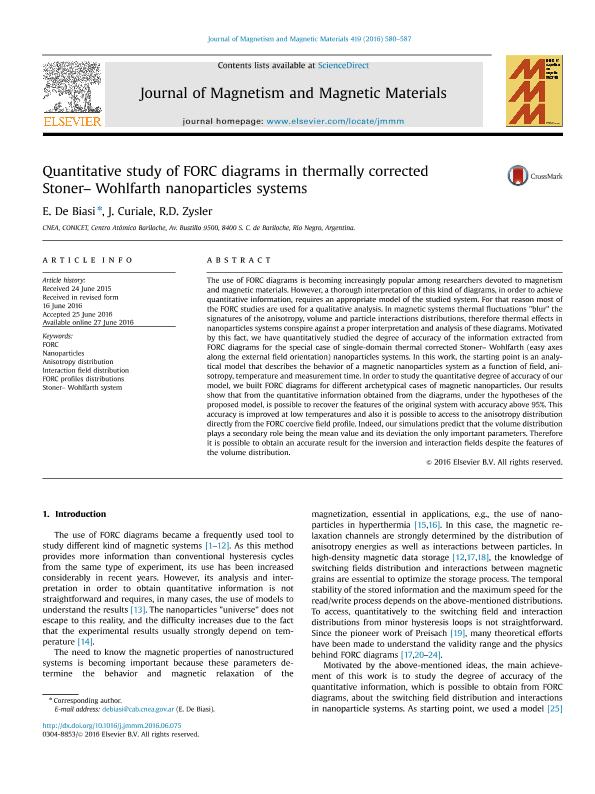Mostrar el registro sencillo del ítem
dc.contributor.author
de Biasi, Emilio

dc.contributor.author
Curiale, Carlos Javier

dc.contributor.author
Zysler, Roberto Daniel

dc.date.available
2021-02-19T19:21:15Z
dc.date.issued
2016-12-01
dc.identifier.citation
de Biasi, Emilio; Curiale, Carlos Javier; Zysler, Roberto Daniel; Quantitative study of FORC diagrams in thermally corrected Stoner– Wohlfarth nanoparticles systems; Elsevier Science; Journal of Magnetism and Magnetic Materials; 419; 1-12-2016; 580-587
dc.identifier.issn
0304-8853
dc.identifier.uri
http://hdl.handle.net/11336/126150
dc.description.abstract
The use of FORC diagrams is becoming increasingly popular among researchers devoted to magnetism and magnetic materials. However, a thorough interpretation of this kind of diagrams, in order to achieve quantitative information, requires an appropriate model of the studied system. For that reason most of the FORC studies are used for a qualitative analysis. In magnetic systems thermal fluctuations “blur” the signatures of the anisotropy, volume and particle interactions distributions, therefore thermal effects in nanoparticles systems conspire against a proper interpretation and analysis of these diagrams. Motivated by this fact, we have quantitatively studied the degree of accuracy of the information extracted from FORC diagrams for the special case of single-domain thermal corrected Stoner– Wohlfarth (easy axes along the external field orientation) nanoparticles systems. In this work, the starting point is an analytical model that describes the behavior of a magnetic nanoparticles system as a function of field, anisotropy, temperature and measurement time. In order to study the quantitative degree of accuracy of our model, we built FORC diagrams for different archetypical cases of magnetic nanoparticles. Our results show that from the quantitative information obtained from the diagrams, under the hypotheses of the proposed model, is possible to recover the features of the original system with accuracy above 95%. This accuracy is improved at low temperatures and also it is possible to access to the anisotropy distribution directly from the FORC coercive field profile. Indeed, our simulations predict that the volume distribution plays a secondary role being the mean value and its deviation the only important parameters. Therefore it is possible to obtain an accurate result for the inversion and interaction fields despite the features of the volume distribution.
dc.format
application/pdf
dc.language.iso
eng
dc.publisher
Elsevier Science

dc.rights
info:eu-repo/semantics/openAccess
dc.rights.uri
https://creativecommons.org/licenses/by-nc-sa/2.5/ar/
dc.subject
ANISOTROPY DISTRIBUTION
dc.subject
FORC
dc.subject
FORC PROFILES DISTRIBUTIONS
dc.subject
INTERACTION FIELD DISTRIBUTION
dc.subject
NANOPARTICLES
dc.subject
STONER– WOHLFARTH SYSTEM
dc.subject.classification
Física de los Materiales Condensados

dc.subject.classification
Ciencias Físicas

dc.subject.classification
CIENCIAS NATURALES Y EXACTAS

dc.title
Quantitative study of FORC diagrams in thermally corrected Stoner– Wohlfarth nanoparticles systems
dc.type
info:eu-repo/semantics/article
dc.type
info:ar-repo/semantics/artículo
dc.type
info:eu-repo/semantics/publishedVersion
dc.date.updated
2021-02-09T18:47:07Z
dc.journal.volume
419
dc.journal.pagination
580-587
dc.journal.pais
Países Bajos

dc.journal.ciudad
Amsterdam
dc.description.fil
Fil: de Biasi, Emilio. Comisión Nacional de Energía Atómica. Gerencia del Área de Investigación y Aplicaciones No Nucleares. Gerencia de Física. Laboratorio de Resonancias Magnéticas; Argentina. Consejo Nacional de Investigaciones Científicas y Técnicas. Centro Científico Tecnológico Conicet - Patagonia Norte; Argentina
dc.description.fil
Fil: Curiale, Carlos Javier. Comisión Nacional de Energía Atómica. Gerencia del Área de Investigación y Aplicaciones No Nucleares. Gerencia de Física. Laboratorio de Resonancias Magnéticas; Argentina. Consejo Nacional de Investigaciones Científicas y Técnicas. Centro Científico Tecnológico Conicet - Patagonia Norte; Argentina
dc.description.fil
Fil: Zysler, Roberto Daniel. Comisión Nacional de Energía Atómica. Gerencia del Área de Investigación y Aplicaciones No Nucleares. Gerencia de Física. Laboratorio de Resonancias Magnéticas; Argentina. Consejo Nacional de Investigaciones Científicas y Técnicas. Centro Científico Tecnológico Conicet - Patagonia Norte; Argentina
dc.journal.title
Journal of Magnetism and Magnetic Materials

dc.relation.alternativeid
info:eu-repo/semantics/altIdentifier/url/http://linkinghub.elsevier.com/retrieve/pii/S0304885316312409
dc.relation.alternativeid
info:eu-repo/semantics/altIdentifier/doi/http://dx.doi.org/10.1016/j.jmmm.2016.06.075
Archivos asociados
